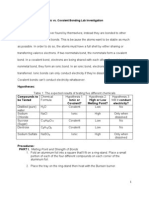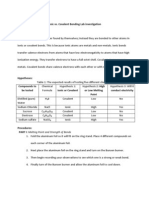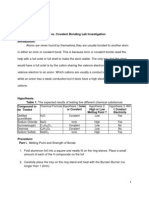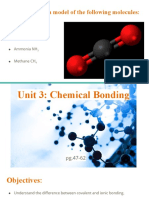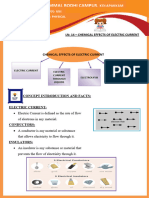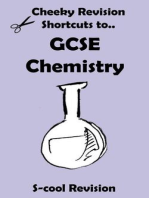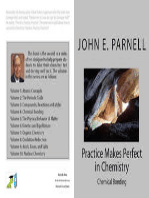Ionic v. Covalent Bonding Lab Investigation
Ionic v. Covalent Bonding Lab Investigation
Uploaded by
JackelineCopyright:
Available Formats
Ionic v. Covalent Bonding Lab Investigation
Ionic v. Covalent Bonding Lab Investigation
Uploaded by
JackelineOriginal Description:
Original Title
Copyright
Available Formats
Share this document
Did you find this document useful?
Is this content inappropriate?
Copyright:
Available Formats
Ionic v. Covalent Bonding Lab Investigation
Ionic v. Covalent Bonding Lab Investigation
Uploaded by
JackelineCopyright:
Available Formats
Jackeline Ruiz Period 4 November 9, 2012 Ionic v.
Covalent Bonding Lab Investigation Introduction: Most atoms are never found by themselves; instead they are bonded to other atoms through an ionic or covalent bond because the atoms need to form an octet to become stable. Covalent compounds bond when a non-metal shares valence electrons with another non-metal. Covalent bonds share the valence electrons to form a full octet. A covalent bond has a weak structure because theyre negative therefore has a low melting point. Ionic bonds are metals that transferred their valence electron to non-metals. The metal is the transferor of its valence electrons to the non-metals because a non-metal has high electronegativity. These bonds have a high melting point because it has a crystal lattice structure therefore has a strong bond. The hypotheses I created was that the ionic compounds are those with low melting points and do conduct electricity. The covalent compounds are solutions with high melting points and do not conduct electricity. The reason for this experiment is to distinguish the different bonds that occur with different materials. Hypotheses: Table 1: The expected results of testing five different chemicals. Chemical Hypothesis 1: Hypothesis 2: High Hypothesis 3: Will Formula Ionic or or Low Melting it conduct Covalent? Point? electricity? Distilled (pure) H2O Ionic Low Melting No Water Sodium chloride NaCl Ionic Low Melting Yes Sucrose (sugar) C12H22O11 Covalent High Melting No Dextrose C6H12O6 Covalent High Melting No Sodium sulfate NaSO4 Ionic Low Melting Yes Compounds to be Tested Procedures: Part I. Melting Point and Strength of Bonds 1. Aluminum foil was shaped into a square.
2. The square of foil was placed on a tray on a ring stand with a Bunsen burner beneath it 3. Observations were to be carefully recorded. 4. The square of foil then cooled down and was ready to be rinsed off. Part II. Electrical Conductivity 1. The dried compound was tested for conductivity. Observations were recorded. 2. Drops of distilled water were dropped into the compound to dissolve it. 3. The solution was tested for conductivity. Observations were recorded. 4. The conductivity tester was washed carefully after every use to avoid contamination. 5. All steps were repeated for every five compounds. Results: Table 2: The results of testing five different chemicals Name/Chemical Part I: Melting Point Part II: Conduct Final Conclusion: Formula (15; High, Med. or Electricity (Yes/No) Ionic or Covalent Low?) Bonds? Dry Dissolved 1. Distilled (pure) 1= lowest: (already N/A No Covalent Water/ H2O melted) 2. Sodium Chloride/ High No Yes Ionic NaCl 3. Sucrose (sugar)/ Low No No Covalent C12H22O11 4. Dextrose/ C6H12O6 Med No No Covalent 5. Sodium sulfate/ High No Yes Ionic NaSO4 Conclusion: After this laboratory, it was concluded that sodium chloride and sodium sulfate were ionic compounds versus sucrose and dextrose were covalent compounds. All of the initial hypotheses were incorrect. From the results, the ionic compounds were those that conducted electricity in water and had a high melting point. However, the covalent compounds didnt conduct electricity when dissolved in water and had a low melting point. The ionic bonds form a
crystal lattice structure. The ionics are formed from metal cations (+) and non-metals anions (-) so when they dissolve in water electricity can flow through the solution. Additionally, ionic bonds are very strong since they have a high electrostatic attraction between the cations and anions. Covalent bonds form a molecule structure. The covalent compounds dont conduct electricity because they do not form ions, which cause them to be insulators and not conduct electricity when dissolved in water. Furthermore, covalent bonds have a weak bond because the atoms have no electrostatic attraction. That is how the observer was able to distinguish the different bonds with different solutions in the experiments.
You might also like
- Larkin Lab ReportDocument3 pagesLarkin Lab ReportChristopherAguilar33% (3)
- Experiment 5 Properties of Ionic and Covalent CompoundsDocument5 pagesExperiment 5 Properties of Ionic and Covalent CompoundsAbdul Rahman Abdul Najib100% (1)
- Christian Lara Lab ReportDocument3 pagesChristian Lara Lab ReportLeslieNo ratings yet
- Ionic vs. Covalent Bonding Lab Investigation: HypothesesDocument3 pagesIonic vs. Covalent Bonding Lab Investigation: HypothesesLeslieNo ratings yet
- Ionic vs. Covalent Bonding Lab InvestigationDocument3 pagesIonic vs. Covalent Bonding Lab InvestigationLeslieNo ratings yet
- Ionic vs. Covalent Bonding Lab InvestigationDocument3 pagesIonic vs. Covalent Bonding Lab InvestigationLeslieNo ratings yet
- Ionic vs. Covalent Bonding Lab InvestigationDocument4 pagesIonic vs. Covalent Bonding Lab InvestigationAngelicaNo ratings yet
- Hypothesis:: Compounds To Be Tested Ionic or Covalent High or Low Melting Point? Electricity?Document3 pagesHypothesis:: Compounds To Be Tested Ionic or Covalent High or Low Melting Point? Electricity?LeslieNo ratings yet
- Bonding Lab RportDocument3 pagesBonding Lab RportMarlynNo ratings yet
- Ionic vs. Covalent Bonding Lab InvestigationDocument3 pagesIonic vs. Covalent Bonding Lab InvestigationIngridNo ratings yet
- Ionic vs. Covalent Bonding Lab Investigation: Carefully On The Square FoilDocument3 pagesIonic vs. Covalent Bonding Lab Investigation: Carefully On The Square FoilLeslieNo ratings yet
- Ionic vs. Covalent Bonding Lab InvestigationDocument3 pagesIonic vs. Covalent Bonding Lab InvestigationLeslieNo ratings yet
- 4 Italo Calderon Lab ReportDocument3 pages4 Italo Calderon Lab ReportLeslieNo ratings yet
- Katia Medina Larkin 2Document3 pagesKatia Medina Larkin 2kmedina2014No ratings yet
- Ionic vs. Covalent Bonding Lab InvestigationDocument3 pagesIonic vs. Covalent Bonding Lab InvestigationItaloNo ratings yet
- Ionic vs. Covalent Bonding Lab InvestigationDocument3 pagesIonic vs. Covalent Bonding Lab InvestigationMarcoluisNo ratings yet
- Ionic vs. Covalent Bonding Lab InvestigationDocument3 pagesIonic vs. Covalent Bonding Lab InvestigationLeslieNo ratings yet
- Ionic vs. Covalent Bonding Lab InvestigationDocument3 pagesIonic vs. Covalent Bonding Lab InvestigationitzelNo ratings yet
- Ionic vs. Covalent Bonding Lab ReportDocument3 pagesIonic vs. Covalent Bonding Lab ReportLeslieNo ratings yet
- Larkin's Lab ReportDocument3 pagesLarkin's Lab ReportRicardoNo ratings yet
- Jose Camacho Chem LABDocument3 pagesJose Camacho Chem LABLeslieNo ratings yet
- Matthew McClain Lab Report Period 4Document4 pagesMatthew McClain Lab Report Period 4mmcclain2014No ratings yet
- Ionic vs. Covalent Bonding Lab InvestigationDocument3 pagesIonic vs. Covalent Bonding Lab InvestigationLeslieNo ratings yet
- 4 Sydney CarrollDocument3 pages4 Sydney CarrollLeslieNo ratings yet
- 8 Thhourlab 9 BakerbrunatikallalkaneoberlanderDocument5 pages8 Thhourlab 9 Bakerbrunatikallalkaneoberlanderapi-297169088No ratings yet
- Ionic vs. Covalent Bonding Lab Investigation: PART I. Melting Point and Strength of BondsDocument3 pagesIonic vs. Covalent Bonding Lab Investigation: PART I. Melting Point and Strength of BondsLeslieNo ratings yet
- Experiment 5 Dissimilarity Between Ionic and Covalent CompoundsDocument5 pagesExperiment 5 Dissimilarity Between Ionic and Covalent CompoundsNurasyilah YakubNo ratings yet
- Ionic vs. Covalent Bonding Lab InvestigationDocument4 pagesIonic vs. Covalent Bonding Lab InvestigationLeslieNo ratings yet
- Lab 4 ReportDocument5 pagesLab 4 Reportaadi.nitin.deNo ratings yet
- Ionic vs. Covalent Bonding Lab InvestigationDocument2 pagesIonic vs. Covalent Bonding Lab InvestigationLeslieNo ratings yet
- Chemistry Experiment: Ionic and Covalent BondDocument4 pagesChemistry Experiment: Ionic and Covalent BondAhmad FerdausNo ratings yet
- Al Ittihad Private School Jumeira Science Department 2021/2022Document4 pagesAl Ittihad Private School Jumeira Science Department 2021/2022budoorNo ratings yet
- Differences Between Ionic and Covalent Compounds: Group A Group BDocument2 pagesDifferences Between Ionic and Covalent Compounds: Group A Group BGlendel H. OrlandaNo ratings yet
- Chapter 5 Chemical BondDocument8 pagesChapter 5 Chemical Bondمسنيزواتي محمد نورNo ratings yet
- Chemical Bond (ContDocument18 pagesChemical Bond (ContJachinta JuliusNo ratings yet
- Unit 3 - Chemical BondingDocument58 pagesUnit 3 - Chemical BondingTrang Vũ Thị BằngNo ratings yet
- Chemistry Lab PresentationDocument5 pagesChemistry Lab PresentationIhfaz NoorNo ratings yet
- Chemistry Form 4 Chapter 5Document8 pagesChemistry Form 4 Chapter 5ManiArasiChandranNo ratings yet
- Topic 1-5 Revision ChemDocument5 pagesTopic 1-5 Revision Chemchloe daviesNo ratings yet
- Structure and BondingDocument72 pagesStructure and BondingUnknownKidNo ratings yet
- ChemistryDocument15 pagesChemistryTGC NINJANo ratings yet
- (C1) Chemical Bond LabDocument2 pages(C1) Chemical Bond Lababdelrahmanadelm2008No ratings yet
- Electrolyte and NonDocument7 pagesElectrolyte and NonSuwahono, M.PdNo ratings yet
- Ionic BondDocument6 pagesIonic BondDivyashri ShendeNo ratings yet
- Rajkumar Chemistry 2-1Document13 pagesRajkumar Chemistry 2-1Gopala krishnanNo ratings yet
- 3RD Quarter Chem 1 IonsDocument6 pages3RD Quarter Chem 1 IonsThaddeus BaldonadoNo ratings yet
- Laboratory Act #9Document24 pagesLaboratory Act #9Bianca Geagonia100% (4)
- Chemical Bonding IIDocument7 pagesChemical Bonding IIdanielmahsaNo ratings yet
- (C1) Chemical Bond LabDocument3 pages(C1) Chemical Bond Lababdelrahmanadelm2008No ratings yet
- Comparing Covalent and Ionic Lattices S4Document3 pagesComparing Covalent and Ionic Lattices S4Fatima Ahmed-VeriterNo ratings yet
- PHYSICS NOTES - CHEMICAL EFFECTS OF ELECTRIC CURRENT - CLASS VIII - FINAL - CombinedDocument20 pagesPHYSICS NOTES - CHEMICAL EFFECTS OF ELECTRIC CURRENT - CLASS VIII - FINAL - CombinedB. Guru PrasadNo ratings yet
- LABREPORT1Document6 pagesLABREPORT1julinka beyla yansonNo ratings yet
- Chemical Bonding-Wps OfficeDocument16 pagesChemical Bonding-Wps OfficeJoel TitusNo ratings yet
- GCSE Chemistry Revision: Cheeky Revision ShortcutsFrom EverandGCSE Chemistry Revision: Cheeky Revision ShortcutsRating: 4.5 out of 5 stars4.5/5 (3)
- Practice Makes Perfect in Chemistry: Chemical BondingFrom EverandPractice Makes Perfect in Chemistry: Chemical BondingRating: 5 out of 5 stars5/5 (3)
- The Romance of War Inventions: A Description of Warships, Guns, Tanks, Rifles, Bombs, and Other Instruments and Munitions of Warfare, How They Were Invented & How They Are EmployedFrom EverandThe Romance of War Inventions: A Description of Warships, Guns, Tanks, Rifles, Bombs, and Other Instruments and Munitions of Warfare, How They Were Invented & How They Are EmployedNo ratings yet
- Combining Chemicals - Fun Chemistry Book for 4th Graders | Children's Chemistry BooksFrom EverandCombining Chemicals - Fun Chemistry Book for 4th Graders | Children's Chemistry BooksNo ratings yet
- Practice Makes Perfect in Chemistry: Chemical Bonding with AnswersFrom EverandPractice Makes Perfect in Chemistry: Chemical Bonding with AnswersRating: 5 out of 5 stars5/5 (1)
- Practice Makes Perfect in Chemistry: Acids, Bases, and Salts with AnswersFrom EverandPractice Makes Perfect in Chemistry: Acids, Bases, and Salts with AnswersNo ratings yet



